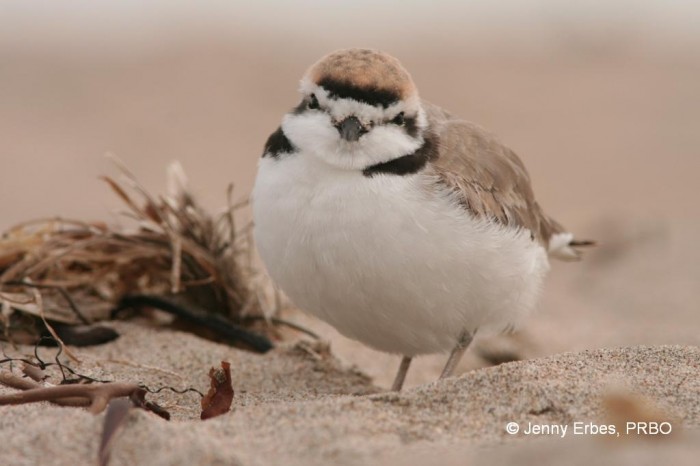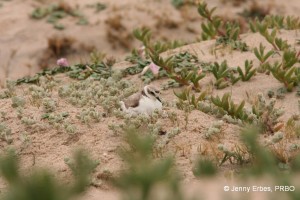To live on the beach, bask in the sun, scrape a nest in the sand, run near the waves and make love along the dunes is to live the life of a snowy plover.
Western snowy plovers or Charadrius alexandrines nivosus are cute little birds that inhabit prime waterfront property along California’s coast and inland water bodies. Weighing just one to two ounces and reaching six and a half inches in length, snowy plovers are designed to blend in with their environment. Their back feathers are a sandy brown and the stomach feathers are fluffy white. This color scheme is accentuated by a stout black bill, dark gray legs, black eyes and a white ring around the neck.
For several months of the year males and females look alike, but once breeding season begins males develop a few distinguishing characteristics. The head is topped by a rust colored cap and black feathers appear around the ears, side of the neck and crown. The black crown looks like the bird version of a unibrow, just one strip of solid black across the forehead. Sometimes females also display breeding plumage, so it’s not a perfect identification system because there are always exceptions to the rule.
A male (and sometimes female) with a unibrow means it’s time to get it on! And I don’t know if it’s the unibrow or what, but boy do the snowy plovers have a crazy little mating ritual.
According to the Birds of North America database, males make the first move by standing and calling from their territories. If a lady happens to be quite close, then she may be treated to the “horizontal display.” This is when a male leans forward into a low-lying crouch, which makes him look like a stalker or robber trying to keep his head below a window while walking.
Then the male runs to a spot along the beach and starts scraping the ground or sand with his feet. Next the female runs over to the same place and the male steps out so she can step in. She takes her turn at scratching the ground with her feet while rotating on her breast.
The next series of moves resembles a form of dirty square dancing.
The male bows (bow to your partner) next to the female, sometimes once, other times repeatedly. While bowing, the male flashes the white of his tail (bow to your partner and flash your ass) and the female stops scraping and runs a very short distance. She stands with her body tilted forward (bow to your corner). The male follows and stands behind her (twisted do-si-do), but the whole time is raising his legs in the air like he is high-stepping in place (promenade).
The male then jumps on the female’s back and starts rhythmically massaging her back by shifting his weight from one leg to the other (promenade on your partner’s back). This is followed by a lot of tail waving as both male and female start shifting their tails from side-to-side faster and faster (sashay with the tail really fast). When it’s time to have sex the male grasps the female’s neck with his bill and they both fall backwards with their wings partially extended (fall on your partner).
This final dramatic step lasts two seconds and then they are back up, standing around like it never happened. Suddenly, mundane daily tasks such as preening and searching for food are much more interesting than the bird of the opposite sex standing nearby.
Despite no post-coital cuddling, snowy plover couples stay together until the eggs are laid and hatched. Very shallow nests are scraped in the sand next to driftwood, kelp or any type of beach debris that will help protect the eggs, which are incubated by the male and female.
The situation becomes interesting because snowy plovers practice facultative polyandrous breeding, which means that when conditions are right, after the eggs hatch females will ditch the new family and go off to find another mate to start another nest. Polyandry is the lesser known female version of polygamy. But sometimes male snowy plovers also practice polygamy. Snowy plovers really get around!
Lynne Stenzel, a Wetlands Program Biologist for PRBO Conservation Science, has studied snowy plovers for many years and explained, “Their polygamy is mostly polyandrous, since it is almost always the male that is left with the brood but, because of their lengthy breeding season some males will also make a second attempt in the season with a different female after fledging or losing their first broods.”
The male is left to raise the chicks on his own and once he is successful or unsuccessful he may decide to mate again. Females call the shots by taking off first to start a second family and sometimes even a third. This can go on for awhile since nesting season lasts from March through August.
Mother Nature does like to switch things up a bit every once in awhile, but in this case she put extra safe guards in place. According to the PRBO Conservation Science website, snowy plover chicks can feed themselves immediately upon birth, just like chickens.
Chicks are born with adult size legs, looking more like awkward adolescents than chicks, and sandy feathers with black spots for extreme beach camouflage. This allows them to start hunting in the sand for beetles, flies and insect larvae right away. (Snowy plovers do scurry along the beach on their little legs, but shouldn’t be confused with sanderlings who constantly run in and out with the waves. Snowy plovers scurry all over the beach.)
Lucky for dad, he just has to worry about keeping the chicks warm and protecting them from predators for about four weeks until they can fly on their own. In Los Angeles County this is a full time job that became so difficult snowy plovers gave up nesting here.
“Although Los Angeles County is very central to their breeding range and egg collectors of the early 20th Century found many clutches of eggs on Los Angeles County beaches,” Stenzel said. “They have not bred there for many decades.”
In general, snowy plovers are not doing that great.
“Their federal status is called threatened, which indicates that without protective actions, their populations would likely become endangered,” Stenzel said. “We believe that without the protection they receive from their status, their coastal breeding populations would surely continue to decline and lose beach areas for nesting due to the high levels of disturbance and habitat destruction they experience.”
Beach living is not all it’s cracked up to be.
To live on the beach, be crushed by vehicles, raked by beach sweepers, chased by dogs, eaten by feral cats and trampled by people is to live the life of the snowy plover.
Next time you visit a beach help out the snowy plover; walk on wet sand, keep your dog on a leash, stay away from fenced off enclosures that protect snowy plovers and step carefully. The beach is the snowy plovers’ home, do what you can to allow them to keep dirty square dancing in the sand.


“standing around like it never happened” – why does that sound so familiar? Very interesting post, and really great how you brought it back around at the end to show that being a threatened species as not as romantic as life on the beach makes it sound. I grew up with a fellow who works with the also-threatened piping plover in Massachusetts. Here is a link to the reserve where their habitat is. http://www.nature.org/wherewework/northamerica/states/massachusetts/preserves/art5331.html
Thanks again for more great info!